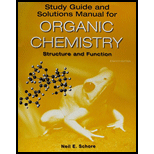
EBK STUDY GUIDE/SOLUTIONS MANUAL FOR OR
8th Edition
ISBN: 9781319255572
Author: SCHORE
Publisher: VST
expand_more
expand_more
format_list_bulleted
Concept explainers
Question
Chapter 5, Problem 64P
(a)
Interpretation Introduction
Interpretation: Thestereocenter in dextromethorphan needs to be determined.
Concept Introduction: The stereocentre are those points where the four different groups are attached to single atom.
(b)
Interpretation Introduction
Interpretation: The enantiomers of the dextromethorphan needs to be determined.
Concept Introduction: Enantiomers have the same molecular formula, but the arrangements of the groups are different from each other.
(c)
Interpretation Introduction
Interpretation: The R and S configuration of the enantiomers needs to be determined.
Concept Introduction: The configuration of the atom is decided by the rotation of the atom around the chiral atom. If clockwise rotates then R configuration otherwise S configuration.
Expert Solution & Answer
Want to see the full answer?
Check out a sample textbook solution
Students have asked these similar questions
Draw the products of this reduction of a ketone with sodium borohydride.
Use a dash or wedge bond to indicate the stereochemistry of substituents on
asymmetric centers, where applicableIgnore any inorganic byproducts.
1) NaBH4
2) HCI/H2O
Select to Draw
Why do you think people who live at high altitudes are advised to add salt to water when boiling food like pasta? What mole fraction of NaCl is needed to raise the boiling point of H2O by 3˚C? Does the amount of salt added to water (typically about one teaspoon to four quarts of water) substantially change the boiling point? (Kb (H2O) = 0.51˚C/molal.)
pls help asap
Chapter 5 Solutions
EBK STUDY GUIDE/SOLUTIONS MANUAL FOR OR
Ch. 5.1 - Prob. 5.3ECh. 5.1 - Prob. 5.4ECh. 5.1 - Prob. 5.5ECh. 5.2 - Prob. 5.6ECh. 5.2 - Prob. 5.8TIYCh. 5.3 - Prob. 5.9ECh. 5.3 - Prob. 5.11TIYCh. 5.3 - Prob. 5.12ECh. 5.4 - Prob. 5.13ECh. 5.4 - Prob. 5.14E
Ch. 5.4 - Prob. 5.16TIYCh. 5.4 - Prob. 5.17ECh. 5.5 - Prob. 5.18ECh. 5.5 - Prob. 5.19ECh. 5.5 - Prob. 5.20ECh. 5.6 - Prob. 5.21ECh. 5.6 - Prob. 5.22ECh. 5.6 - Prob. 5.23ECh. 5.7 - Prob. 5.24ECh. 5.7 - Prob. 5.26TIYCh. 5.7 - Prob. 5.27ECh. 5 - Prob. 5.1ECh. 5 - Prob. 5.2ECh. 5 - Prob. 30PCh. 5 - Prob. 31PCh. 5 - Prob. 32PCh. 5 - Prob. 33PCh. 5 - Prob. 34PCh. 5 - Prob. 35PCh. 5 - Prob. 36PCh. 5 - Prob. 37PCh. 5 - Prob. 38PCh. 5 - Prob. 39PCh. 5 - Prob. 40PCh. 5 - Prob. 41PCh. 5 - Prob. 42PCh. 5 - Prob. 43PCh. 5 - Prob. 44PCh. 5 - Prob. 45PCh. 5 - Prob. 46PCh. 5 - Prob. 47PCh. 5 - Prob. 48PCh. 5 - Prob. 49PCh. 5 - Prob. 50PCh. 5 - Prob. 51PCh. 5 - Prob. 52PCh. 5 - Prob. 53PCh. 5 - Prob. 54PCh. 5 - Prob. 55PCh. 5 - Prob. 56PCh. 5 - Prob. 57PCh. 5 - Prob. 58PCh. 5 - Prob. 59PCh. 5 - Prob. 60PCh. 5 - Prob. 61PCh. 5 - Prob. 62PCh. 5 - Prob. 63PCh. 5 - Prob. 64PCh. 5 - Prob. 65PCh. 5 - Prob. 66PCh. 5 - Prob. 67PCh. 5 - Prob. 68PCh. 5 - Prob. 69PCh. 5 - Prob. 70PCh. 5 - Prob. 71P
Knowledge Booster
Learn more about
Need a deep-dive on the concept behind this application? Look no further. Learn more about this topic, chemistry and related others by exploring similar questions and additional content below.Similar questions
- pls help asaparrow_forward9. Consider the following galvanic cell: Fe (s) | Fe(NO3)2 (aq) || Sn(NO3)2 (aq) | Sn (s) a. Write an equation for the half reactions occurring at the anode and cathode. b. Calculate the standard cell potential Show all of your work. c. Draw and label the galvanic cell, including the anode and cathode, direction of electron flow, and direction of ion migration.arrow_forwardpls help asaparrow_forward
- 11. Use the equation below to answer the following questions: 2 Al(s) + 3 Cd(NO3)2 (aq) → 2 Al(NO3)3 (aq) + 3 Cd(s) a. What is the net ionic equation for the reaction? b. Which species is a spectator ion in this reaction? Define a spectator ion. c. Identify the oxidizing agent and the reducing agent.arrow_forwardpls help asaparrow_forwardpls help asaparrow_forward
- PLEASE READ!!! I DONT WANT EXAMPLES, I DONT WANT WORDS OR PARAGRAPHS FOR THE MECHANISM!!! THANKS First image: QUESTION 6. I have to show, with ARROWS and STRUCTURES, the mechanism of the reaction at the bottom. Also I have to show by mecanism why the reaction wouldn't work if the alcohol was primary. I also tried to draw the mechanism, tell me what to change. Please note that its an AMIDE thats formed not an AMINE the nitrogen has ONE hydrogen and one Phenyl-C-Phenyl. I already asked for this mechanism and got as a final product ...-NH2 not whats shown on the picture, thank you Ths second part. QUESTION 3. I just need a way to synthesize the lactone A, I already started please continue from where I left it Second image: I simply need the products, substrates or reagents, thank youarrow_forwardIndicate how to prepare a 10% sodium hydroxide (NaOH) solution to a slightly alkaline pH.arrow_forwardCH, CH CH₂ CH₂ Phytyl side chain 5. What is the expected order of elution of compounds A-D below from a chromatography column packed with silica gel, eluting with hexane/ethyl acetate? C D OHarrow_forward
arrow_back_ios
SEE MORE QUESTIONS
arrow_forward_ios
Recommended textbooks for you

Coenzymes and cofactors; Author: CH15 SWAYAM Prabha IIT Madras;https://www.youtube.com/watch?v=bubY2Nm7hVM;License: Standard YouTube License, CC-BY
Aromaticity and Huckel's Rule; Author: Professor Dave Explains;https://www.youtube.com/watch?v=7-BguH4_WBQ;License: Standard Youtube License